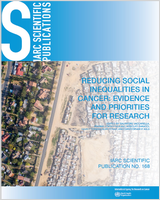NCBI Bookshelf. A service of the National Library of Medicine, National Institutes of Health.
Vaccarella S, Lortet-Tieulent J, Saracci R, et al., editors. Reducing social inequalities in cancer: evidence and priorities for research. Lyon (FR): International Agency for Research on Cancer; 2019. (IARC Scientific Publications, No. 168.)
In order for a variable to be included in a population-based cancer registry, it is important to ensure from the outset that the indicator is feasible to collect in routine settings for virtually all cases within the health system. In practice, this means that the information should be available either routinely in the medical records or via cross-linkages with other databases (e.g. through matching unique identification). In addition, it is important that the variable is sufficiently robust to be stable during the periods before and after the occurrence of a cancer event. Lastly, in terms of the calculation of incidence or mortality rates, it is important that the variable can be stratified by year of diagnosis, age group, and sex. Ideally, this would be aligned with the equivalent strata available in the population censuses.
Example indicators of socioeconomic status include those based on the residential address of the patient (e.g. postal code area), whether it is a rural or urban area of residence, type of health insurance, tax or income data (cross-linked with identification number), and education level. Indicators such as profession, although potentially useful, are very difficult to capture in practice; type of occupation can change with time, and occupation is rarely mentioned in patient records.
If the interest is in outcomes other than incidence or mortality rates, the requirement for comparability of the indicator with census or population register data does not apply, and the list of potential indicators can be extended to any relevant variable that can be captured routinely for all patients. Such variables could be used to stratify analyses of, for example, survival time, stage distribution at diagnosis, and types of treatment received.
Indicators of education level tend to be invalid for younger age groups, because education has not yet been completed. In addition, in many regions with large informal economies, education level is not a very useful indicator. In such economies, informal employment income is often not related to education level, meaning that education level may not be linked to affluence; in particular, women may be dependent on the education level and financial status of their spouse. In general, education level is more often an indicator of the awareness of the need to consult a doctor and the likelihood of following and completing a treatment regime.
- Immunization registries: use of race and ethnicity, and socioeconomic status indicators to identify immunization disparities.[AMIA Annu Symp Proc. 2007]Immunization registries: use of race and ethnicity, and socioeconomic status indicators to identify immunization disparities.Stephan CL. AMIA Annu Symp Proc. 2007 Oct 11; :1124. Epub 2007 Oct 11.
- Racial disparities and socioeconomic status in association with survival in a large population-based cohort of elderly patients with colon cancer.[Cancer. 2007]Racial disparities and socioeconomic status in association with survival in a large population-based cohort of elderly patients with colon cancer.Du XL, Fang S, Vernon SW, El-Serag H, Shih YT, Davila J, Rasmus ML. Cancer. 2007 Aug 1; 110(3):660-9.
- Review Migration and health: exploring the role of migrant status through register-based studies.[Dan Med J. 2015]Review Migration and health: exploring the role of migrant status through register-based studies.Nørredam M. Dan Med J. 2015 Apr; 62(4):B5068.
- Ethnic, Racial, and Socioeconomic Disparities in Retinoblastoma.[JAMA Pediatr. 2015]Ethnic, Racial, and Socioeconomic Disparities in Retinoblastoma.Truong B, Green AL, Friedrich P, Ribeiro KB, Rodriguez-Galindo C. JAMA Pediatr. 2015 Dec; 169(12):1096-104.
- Review Learning to live with complexity: ethnicity, socioeconomic position, and health in Britain and the United States.[Am J Public Health. 2000]Review Learning to live with complexity: ethnicity, socioeconomic position, and health in Britain and the United States.Smith GD. Am J Public Health. 2000 Nov; 90(11):1694-8.
- Incorporating indicators of socioeconomic status or ethnicity in cancer registri...Incorporating indicators of socioeconomic status or ethnicity in cancer registries - Reducing social inequalities in cancer: evidence and priorities for research
Your browsing activity is empty.
Activity recording is turned off.
See more...
